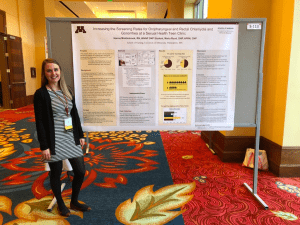This issue of Women’s Healthcare: A Clinical Journal for NPs features poster abstracts presented at the 21st annual NPWH conference in San Antonio in October 2018. These abstracts include those of the first- and second-place poster award winners and the first- and second-place student poster award winners. Abstracts of the podium presenters will appear in the December 2019 issue of the journal. My heartiest congratulations to all! Each year the NPWH conference is enriched by these poster sessions. Please take time to review the abstracts that provide state-of-the-science information about women’s health, and please consider submitting your work for 2020!
FIRST-PLACE POSTER AWARD WINNER
Mothers’ perceptions regarding mother–daughter sexual communication
By Randee L. Masciola, DNP, RN, APRN-CNP, WHNP-BC
Objectives:
1. To examine the attitudes, beliefs, and content knowledge of mothers of adolescent females
2. To identify what mothers perceived as major barriers to effective mother–daughter sexual communication
(MDSC)
3. To identify what mothers perceived as major facilitators of effective MDSC
Purpose:
The goal of this study was to contribute to the body of knowledge on MDSC and to develop a deeper understanding of the attitudes, beliefs, and knowledge that mothers perceive as compromising or promoting MDSC.
Methodology:
This qualitative study investigated MDSC from the mother’s perceptions. Ten mothers of adolescent females were recruited via convenience sample and participated in one-on-one interviews. Interviews were semi-structured and focused on the research questions. Transcripts were analyzed for themes and categories using steps of Data Analysis and Interpretation outlined by Hesse-Biber and Levy. These steps included the data preparation phase, data exploration phase, data reduction
phase, and interpretation phase.
Results:
Mothers perceived their role as being a primary resource of sexual health information and an educator. The data revealed that the mothers felt confident in their content knowledge and attitude to answer any questionsasked by their daughters. Perceived barriers identified by the mothers included lack of initiation of sexual communication by their adolescent daughters and fear of causing discomfort and embarrassment to their daughters. Mothers perceived signs of their daughters’ puberty and the scheduled in-school health talks as significant facilitators to MDSC.
Implications for women’s healthcare:
Advanced practice registered nurses (APRNs) who provide healthcare for female adolescents and women are at the front line when it comes to addressing mothers’ concerns about their daughters’ sexual health. Promoting MDSC can improve these adolescents’ sexual health and decrease the likelihood of their engaging in risky sexual behaviors. Identifying barriers to MDSC can allow APRNs to create and implement interventions that can substitute facilitators for barriers to effective communication. Identifying facilitators can help APRNs build upon strategies already working, create resources to strengthen these connections, and show mothers how to capitalize on opportunities to initiate MDSC. APRN-developed interventions could potentially be school or community-based or used by individual clinicians in primary care. A partnership among parents, schools, and communities and an interdisciplinary approach among pediatric, primary care, women’s health, and mental health providers could create sustainable interventions to help foster MDSC and produce the best outcomes for adolescents’ sexual health.
SECOND-PLACE POSTER AWARD WINNER
Sexual health knowledge, attitudes, and beliefs among nurse practitioners and certified nurse-midwives who work with adolescents in non-acute care settings
By Julia Minoia, DrNP, RN, WHNP and Barbara Posmontier, PhD, CNM, PMHNP-BC
Objectives:
1. To review current barriers to adolescent sexual healthcare
2. To compare sexual health knowledge, attitudes, and beliefs among WHNPs and CNMs/CMs with those of nurse practitioners in other specialties (ANPs, FNPs, PNPs, PMHNPs) who work with adolescents
3. To discuss strategies for improved competency-based curricula in NP and CNM/CM educational programs with outcomes for prevention and protection of adolescents’ sexual health
 Purpose:
Purpose:
This survey was conducted to determine whether there were any differences between WHNPs/CNMs/CMs and NPs in other specialties (ANPs, FNPs, PNPs, and PMHNPs) regarding knowledge, attitudes, and beliefs with respect to adolescent sexual health.
Methodology:
A descriptive, cross-sectional, web-based survey was administered to a sample of NPs and CNMs/CMs (N = 204) recruited through e-newsletters of the National Association of Nurse Practitioners in Women’s Health (NPWH) and the Nurse Practitioner Association New York State. The survey consisted of demographic questions and the Sex Knowledge Attitude Test, the Sexuality Attitudes and Beliefs Survey, and the National Violence Against Women Survey (NVAWS) to explore sexuality knowledge and attitudes, beliefs about addressing adolescents’ sexual health, and personal experience of sexual violence. The group of WHNPs (n = 148) and CNMs/CMs (n = 13) was compared with the group of NPs in other specialties: FNPs (n = 31), ANPs (n = 7), PNPs (n = 3), PMHNPs (n = 1), and other (n = 1). Descriptive statistics and bivariate analyses were used to characterize the sample and assess associations between variables. Content analysis was used to examine qualitative data from one open-ended question: What else would you like to tell us regarding your sexual health knowledge, attitudes, and beliefs related to adolescents?
Results:
Among respondents, the mean proportion of their adolescent patients was 27.9% (SD, 17.4). Among respondents to the NVAWS questions (n = 171), 26% reported experiencing sexual violence. Regression analysis showed the WHNP/CNM/CM group, compared with the other group of NPs, had significantly more positive beliefs about addressing adolescent sexual health (β = –3.36; P = .003). Chi-square of attitude scores by region of the U.S. indicated that positive attitudes toward adolescent sexuality varied significantly, with practitioners in the South having the least positive attitude scores (P <.01). Religion (β =1.69; P = .04) and religiosity (β = –6.05; P <.0001) were significant predictors of adolescent sexuality attitudes. Categories derived from the open-ended question responses (n = 29 [17%]) supported quantitative findings of discomfort in addressing adolescents’ sexual health, APRNs’ need for further education, and concern about adolescents’ lack of access to sexual health education and APRN-led services.
Implications for women’s health:
NPs and CNMs/CMs are well positioned in non-acute settings to lead adolescent sexual healthcare. Study findings reinforced the need for a competency-based adolescent sexual health curriculum in APRN educational programs that promotes professional values, compassion, and acceptance to provide adolescent-friendly services and improve sexual health outcomes.
FIRST-PLACE STUDENT POSTER AWARD WINNER
Polycystic ovarian syndrome provider toolkit: A quality improvement project to standardize PCOS patient care
By Madalyn Carlin, RN, BSN, DNP WHNP Student and Stephanie Delkoski, DNP, APRN, WHNP-BC
Editor’s note: This project was completed after the original abstract was submitted.
Problem statement:
With the complex nature of polycystic ovarian syndrome (PCOS), a needs assessment identified that a quality improvement (QI) project would be beneficial to standardize the diagnosis of PCOS and streamline the care of women with PCOS at an urban women’s health clinic.
Purpose/aims:
The purpose of this project was to create a standardized evidence-based toolkit for healthcare providers (HCPs) to utilize when diagnosing PCOS and providing follow-up care. The three goals were (1) to increase comfort with diagnosing PCOS, ruling out other conditions, and providing comprehensive follow-up care, (2) to increase comfort in knowing the referral options for a patient with PCOS, and (3) to provide HCPs with a resource to offer to patients.
Background/significance:
PCOS is a diagnosis of exclusion that requires ruling out other endocrine disorders that mimic the disease. With a diagnosis of PCOS, women are at an increased risk for a variety of other health conditions, including hyperlipidemia, obstructive sleep apnea, type II diabetes, metabolic syndrome, depression, and hypertension, all which require close follow-up care.
Population/system:
Women with symptoms or a diagnosis of PCOS at an urban women’s health clinic in Minnesota.
Framework/project design:
This project followed the PARiHS framework for implementation: (1) Diagnosis algorithm: created using evidence-based testing guidelines, (2) Follow-up screening guideline: outlines the intervals for specific laboratory tests and other screenings after a PCOS diagnosis and at follow-up visits, (3) Referral guide: applicable referrals within the healthcare system, and (4) Patient education pamphlet: for patients after a new diagnosis of PCOS.
Evaluation methods and analysis of evaluation data:
(1) Pre-/post-inservice surveys and a post-implementation survey were used to determine the change in HCPs’ comfort regarding PCOS diagnosis and follow-up care. (2) The patient education pamphlets were placed in the resource room, and those remaining were counted to determine the number that were given to patients.
Results/outcomes/conclusion:
After the educational session, 7 of the 8 HCPs who participated had increased confidence scores in all areas examined. A total of 4 patient pamphlets were given out during the implementation period. The provider toolkit was easily accessible to all HCPs, and the toolkit was structured to allow for quick use, especially when ordering lab tests. The provider toolkit succeeded in reaching the three goals.
SECOND-PLACE STUDENT POSTER AWARD WINNER
Increasing the rates of pharyngeal and rectal site testing for chlamydia and gonorrhea at an adolescent sexual health clinic
By Hanna Middlebrook, DNP WHNP Student and Maria Ruud, DNP, APRN, C-WHNP
 The rates of Chlamydia trachomatis (CT) and gonococcal (GC) infections in Minnesota continue to rise. In the State of Minnesota, CT rates increased by 71% from 2006 to 2016, and GC rates increased by 25% from 2015 to 2016. CT and GC infections disproportionately affect the adolescent population. The adolescent population also reports high rates of oral intercourse, making this project—screening for extra-genital CT/GC infections—even more relevant.
The rates of Chlamydia trachomatis (CT) and gonococcal (GC) infections in Minnesota continue to rise. In the State of Minnesota, CT rates increased by 71% from 2006 to 2016, and GC rates increased by 25% from 2015 to 2016. CT and GC infections disproportionately affect the adolescent population. The adolescent population also reports high rates of oral intercourse, making this project—screening for extra-genital CT/GC infections—even more relevant.
The current practice for the screening of extra-genital (pharyngeal and rectal) CT and GC infections is unstandardized at a local adolescent sexual health clinic. A gap in practice exists between sexual practices reported and anatomic locations tested. There is no protocol in place to ensure that screening is done at the correlating anatomic sites. Of 554 CT tests done in a 3-month period, 10 were rectal and 16 were oral. Of the 556 GC tests done in the 3-month period, 10 were rectal and 16 were oral. These findings yield an extra-genital CT/GC screening rate of 0.047%, which is disproportionately low. The consequence of such a low rate of extragenital screening for CT and GC is that a large number of individuals with undiagnosed and untreated infections can continue to transmit them. The purpose of this project was to increase screening rates for extra-genital CT and GC infections by 20% by September 1, 2018.
Editor’s note: The rest of this abstract, containing the results and the conclusion, was written after the abstract was submitted and the project was completed.
A gap in practice surrounding extragenital screening for CT/GC was identified both nationally and locally. This QI project set out to address concerns of disproportionately low rates of extra-genital screening and the potential for missed infections among at-risk patients. This project successfully standardized the way extra-genital screening for CT/GC was done at the clinic site and increased overall extra-genital screening rates for CT/ GC from pre- to post-intervention by 27%. In addition, 55.6% of the extra-genital infections that were diagnosed during the 2-month pilot would have been missed with urogenital screening alone. Furthermore, in the 3 months following the intervention period, 69.2% of the oropharyngeal and rectal infections diagnosed at the clinic would have been missed with urogenital screening alone. In both sexes, the current diagnosis and treatment of urogenital infections alone overlooks many oral and rectal infections and therefore excludes many patients from receiving the proper treatment they need (Van Liere et al., 2014). This project’s results clinically supported this statement and further revealed the need for increased screening for extra- genital CT/GC infections.

